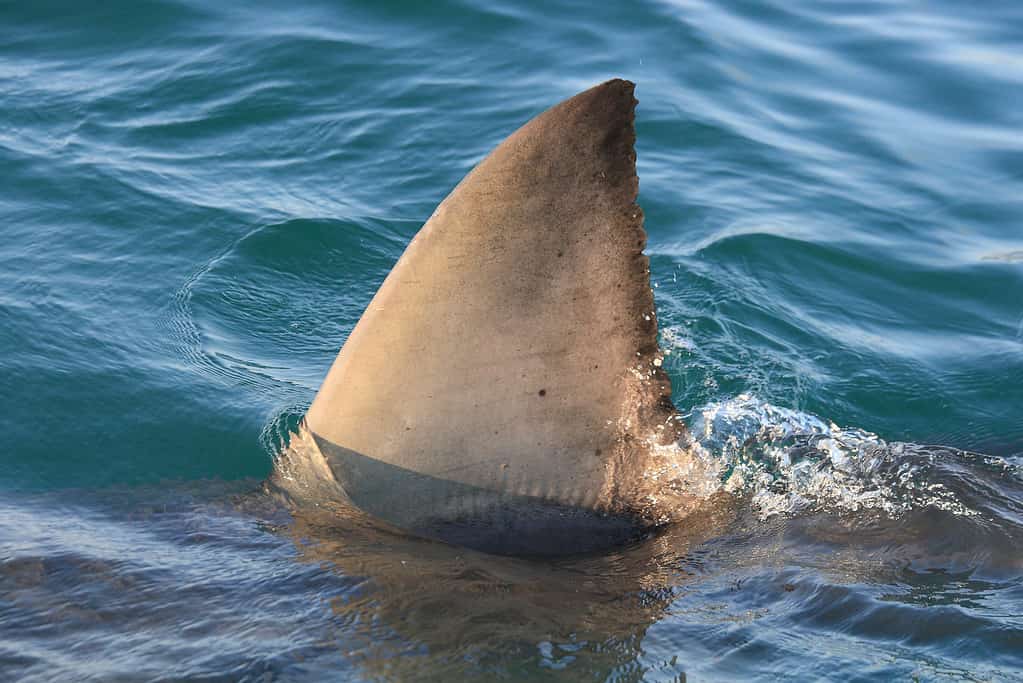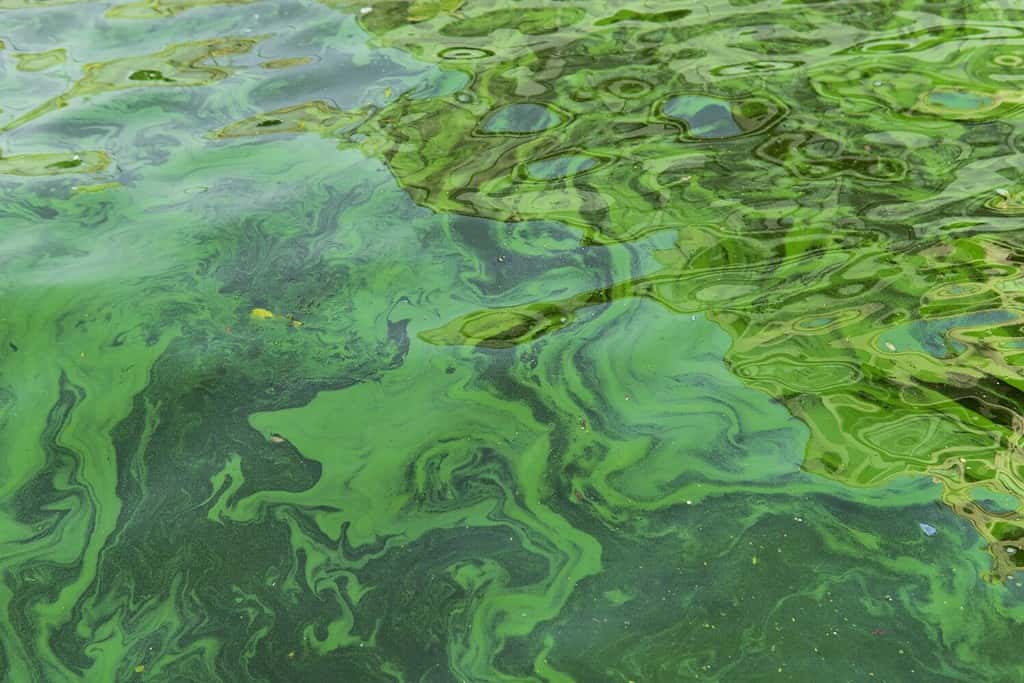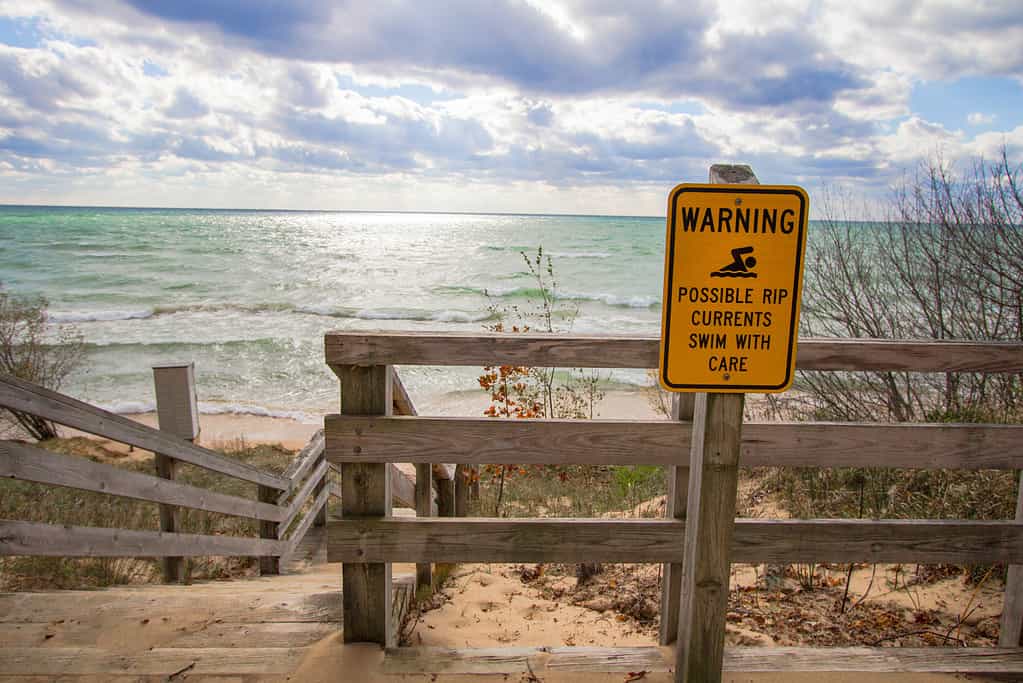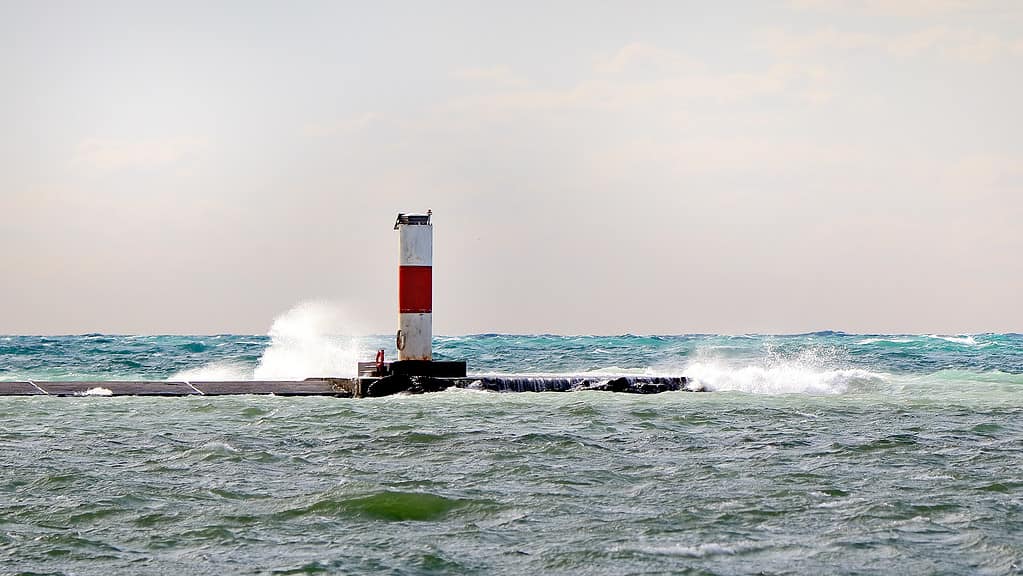Key Points:
- There are no sharks or other fish that pose a risk to human swimmers in Lake Michigan.
- Pollution is present in the lake, mostly from plastic waste that, while posing minimal risk to humans, can harm animals in and around its waters.
- While Lake Michigan is safe for swimming under suitable conditions, it can pose hazards that could be dangerous or even fatal, so adhering to safety guidelines is crucial for staying safe.
Lake Michigan is the second-largest of the Great Lakes in terms of volume, trailing only Lake Superior. It is the only one of the Great Lakes that lies entirely within the United States. In fact, it is the largest lake in the world that is confined to only one country. The lake is bordered by four U.S. states: Michigan, Wisconsin, Illinois, and Indiana. More than 12 million people live along the shores of the lake. Because it is so accessible to so many people, Lake Michigan is a popular destination for boating, fishing, and swimming. But is it safe to swim in Lake Michigan?

Safe for Swimming?
The answer is, it depends. Under the right conditions, Lake Michigan is safe for swimming. But this lake can also present dangerous, even deadly, conditions for swimmers.
So let’s dive in, so to speak, on how to stay safe in Lake Michigan.

No doubt Lake Michigan is beautiful, but is it safe for swimming?
©iStock.com/christiannafzger
No Sharks
For starters, there is no risk of a shark attack because there are no sharks in Lake Michigan or any of the other Great Lakes. There seem to be constant rumors swirling about Great Lakes sharks, but they are always false.
In 2014, the Discovery Channel launched a promotional video that ended up as an embarrassment for the network. In their annual Shark Week promotion, the Discovery Channel released a video purportedly of a shark in Lake Ontario. After the public became alarmed, Paul Lewis, the network’s president, admitted in a statement that the video featured a “life-like prosthetic model shark.”
To make the point redundantly clear: there are no sharks in the Great Lakes, including Lake Michigan. Regardless of the rumors, hype videos, internet hoaxes, or any other propaganda to the contrary, sharks do not inhabit the Great Lakes.
There are also no other fish that pose a risk to human swimmers in Lake Michigan.

Will you encounter a shark in Lake Michigan? Nope!
©iStock.com/Alessandro De Maddalena
Cyanobacteria
Algal blooms occur when temperatures warm and when water is relatively still. High concentrations of certain nutrients also help blooms grow much faster. Some of these blooms release cyanotoxins which can cause skin rashes and blisters. They can also cause breathing difficulties. These blooms can happen in Lake Michigan, but they are relatively rare. When the blooms do occur, they normally remain small and localized.
Lake Erie and Lake Ontario are much more prone to harmful algal blooms. They are smaller, and their waters are warmer. More pollutants in these waters can feed these blooms.

While harmful algal blooms do happen on Lake Michigan, they are rare and are usually small.
©Aleksandrkozak/Shutterstock.com
Pollution
Lake Erie and Lake Ontario are generally considered the most polluted of the Great Lakes, but Lake Michigan’s waters also contain an unacceptable level of pollutants. Most of the pollution is plastic waste, though, which poses little risk to swimmers. The same cannot be said for the animals that live in and around the lake. It is also a concern for the millions of residents whose drinking water comes from the lake.

Each year, more than 22 million pounds of plastic pollution end up in the Great Lakes.
©iStock.com/pcess609
According to the Rochester Institute of Technology, more than 22 million pounds of plastic pollution end up in the Great Lakes each year. Plastic pollution never goes away. Instead, it just breaks down into microplastics. A microplastic is a piece of plastic no larger than 5 millimeters in size or about the size of a pencil eraser. These small plastic particles can take a number of different forms, including beads, fragments, pellets, film, foam, and fibers.
Zooplankton, fish, mussels, and birds are known to eat microplastics, mistaking them for natural food. These plastics can cause a host of problems once ingested. Animals that consume these microplastics can exhibit delayed development, reproductive problems, and a decreased ability to fight off disease.
Lake Michigan also has chemical pollution concerns, such as fertilizer runoff from farm fields. The discharge of an oil refinery on Lake Michigan’s southern tip is also of special concern. Most of Lake Michigan’s beaches are relatively unaffected by this discharge since the majority of the contaminants don’t travel far. Still, such pollution should not be downplayed as insignificant. It poses a serious threat to the wildlife of Lake Michigan as well as the people who rely on it as a water source.
Dangerous Currents
The dangers for Lake Michigan swimmers certainly don’t come from sharks. Pollution is a significant concern for the lake overall, but it doesn’t pose a high risk for most beachgoers. That doesn’t mean that Lake Michigan is always safe for swimmers, though. In fact, more people have died in Lake Michigan than in any of the other Great Lakes.
The statistics provided by the Great Lakes Surf Rescue Project tell the dangerous tale. There were 108 confirmed drownings in the Great Lakes in 2022, along with 12 unknown final outcomes. Here are how those deaths were spread out among the five Great Lakes:
- Lake Michigan: 45 drownings (+6 unknown final outcome or cause of death)
- Lake Erie: 24 drownings (+4 unknown final outcome or cause of death)
- Lake Ontario: 21 drownings (+1 unknown cause of death)
- Lake Huron: 12 drownings (+1 unknown final outcome)
- Lake Superior: 6 drownings.
Lake Michigan wins this gruesome competition by a wide margin, partially because it is the most-visited of the five Great Lakes. More swimmers, sadly, mean more drownings. However, Lake Michigan doesn’t lead by such a wide margin only because there are more visitors. The lake itself can create volatile and dangerous conditions.

Lake Michigan has strong currents that can quickly become dangerous.
©iStock.com/TonyaMariePhoto
Longshore Currents
Swift currents pose the greatest risk to swimmers in Lake Michigan. The lake’s elongated shape is conducive for strong longshore currents to form. Those currents run along the shore, hence the name. If you have ever been in the water and then realized that you have drifted down the shore from your beach chair, you were carried there by a longshore current.
Longshore currents are strong and can carry swimmers long distances. If you are caught in a longshore current, swim directly toward the beach.
Rip Currents and Outlet Currents
Rip currents (also known as rip tides or undertow) are powerful currents that move away from the shore. A typical rip current moves at one to two feet per second. Exceptional rip currents can move as fast as eight feet per second.
If you are taken out to deeper water by a rip current, flip over onto your back and float as the current carries you. This will help you conserve your strength. Rip currents do not last long. Once the current dissipates, swim parallel to the beach to get out of the path of the rip current, then swim back to the beach at an angle.
An outlet current is created when a stream or river flows into Lake Michigan. The water flowing from the river into the lake creates a current that can push a swimmer out from the shore into deeper water, similar to a rip current. The method for escaping an outlet current is exactly the same as the method used to escape a rip current.

This sign at a Lake Michigan beach warns swimmers about the strong rip currents.
©ehrlif/Shutterstock.com
Structural Currents
The most dangerous currents in Lake Michigan are structural currents. These currents run alongside structures, such as piers and break walls. They are always present and can be extremely strong, especially in big-wave conditions. As a wave crashes into the structure, the wave’s energy is forced back into the water and collides with the next incoming wave. This creates a washing machine-like condition in the water. Structural currents are relentless, and it is typically impossible to swim out of them and reach the shore, even for physically fit and experienced swimmers.
Most piers are equipped with ladders. Should you get caught in a structural current, try to reach the ladder. Above all, call out for help so someone on the pier can throw you a life preserver or anything else that floats. But visitors to the lake must remember the only real way to stay safe is to never get caught in a structural current in the first place.

Structural currents are the deadliest currents in Lake Michigan, seen here at a lighthouse in Ludington, Michigan.
©iStock.com/John_Wijsman
Stay Calm
If you do get caught in a longshore, rip, or outlet current, remain calm. Panic will only increase the danger. None of these currents will pull you underwater. Knowing how to recognize the currents and how to get out of them is critical for anyone who swims in Lake Michigan.
Waves
There are always waves in Lake Michigan, but the waves are normally two feet high or less. However, there are generally 10-15 days each summer when the waves reach to 3-6 feet high. Those swells create deadly conditions. Over 80% of drownings that are wave and current related happen when the waves are in the 3 to 6-foot range.
The wave periods (the time between waves) in the Great Lakes are much shorter than they are in the ocean. Waves can be 10-20 seconds apart in the ocean. In the Great Lakes, waves can come about every four seconds. When waves are large, swimmers are constantly navigating the strong currents the waves create. A swimmer who is in the water for just 15 minutes is hit with 200 waves. This can be exhausting. If that swimmer then gets caught in a rip current, for instance, their physical strength is already depleted, and they are much more susceptible to drowning.

Lake Michigan’s waves, seen here from New
Buffalo
, Michigan, can become a danger when they swell over three feet high.
©iStock.com/gurineb
Staying Safe in Lake Michigan
Thousands of people visit Lake Michigan each year. If you plan to take a dip in the lake this summer, here are some basic tips to ensure your beach vacation is fun and safe.
1. Pay attention to the surf forecast when visiting the beach. Also, look for the colored flag system used to indicate the surf conditions at the beach.
- Green Flag: Low Hazard
- Yellow Flag: Medium Hazard
- Red Flag: High Hazard
- Double Red Flag: Water Access Closed
2. Know your abilities and your limits. If you are not a strong swimmer or are not in good physical condition, then don’t put yourself in situations that you cannot handle.
3. Do not swim alone. Swimming in a group greatly increases your safety in the water.
4. Never swim around piers and other structures. As noted above, structural currents can be overpowering. Even if the water seems calm, the currents around piers are often much stronger than they may seem.
While thousands of people safely visit Lake Michigan each year, it is the most dangerous of the five Great Lakes for swimmers. Knowing the conditions, recognizing currents, and avoiding structures can ensure a safe, fun-filled experience at the beaches of beautiful Lake Michigan.

The currents around structures, such as the North Pier in Manitowoc, Wisconsin, are unpredictable and extremely dangerous.
©Bill Chizek/Shutterstock.com
The photo featured at the top of this post is © iStock.com/eyfoto
Thank you for reading! Have some feedback for us? Contact the AZ Animals editorial team.






